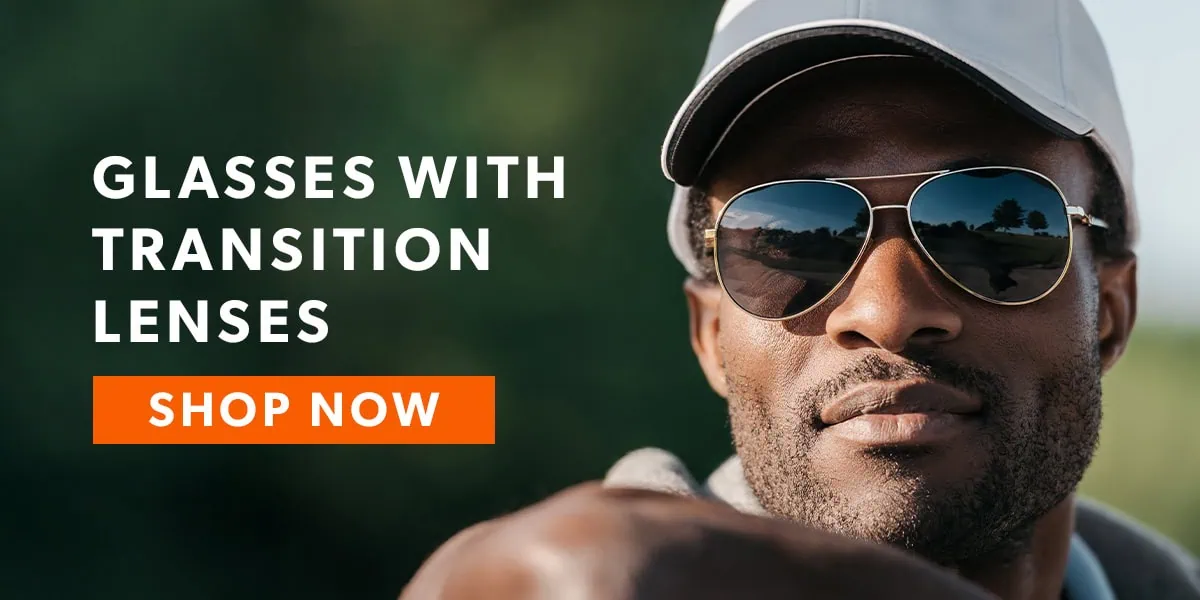- Safety Glasses
- Sports
- Sunglasses
- Eyeglasses
- Safety Products
- Accessories
- Resources


Transition lenses, which automatically adjust to the light in your environment, have come a long way since their initial surge in popularity in the early 1990s. The slow, sometimes ineffective photochromic lens technology was less than optimal, and frames containing these lenses came to be stereotyped as uncool, dorky “Dad glasses.”
Since then, the technology has improved significantly, and glasses with transition lenses are experiencing a resurgence as a fashion-forward accessory and a convenient vision-assisting tool.
Because you’re here, you’re probably wondering whether you can add Transitions®to your existing glasses. In short: Yes, it is possible. We can add transition lenses to almost any glasses frames, but we can’t add the technology to your current lenses. Instead, we’ll need to create new lenses, either prescription or non-prescription, to fit your current frames.
If you wear glasses and are considering transition lenses for existing glasses, consider these factors first.
To swap out your current lenses for Transitions®, your frames must have replaceable lenses. Although we can replace the lenses in most frame styles, even sunglasses, if your glasses have a one-piece molded shield or a visor-style lens, we can’t fit them with new lenses.
Most traditional eyeglass frames should be applicable for lens replacement.
Assess your current frames’ condition. To be eligible for lens replacement, your existing frames must be in good shape, as the stress of replacing lenses can cause breakage.
Even if your frames survive the procedure, if an optician or tech believes they’re likely to break soon afterward, it’s not worth investing in new lenses. You’ll be better off buying an entirely new pair of frames with your new transition lenses.
Transitions® lenses are so popular worldwide that, like Band-Aid or Kleenex, a version of the brand name (transition lenses) is often used interchangeably with the generic product name (photochromic lenses).
Using patented, photochromic dyes, these lenses darken when the sun’s ultraviolet (UV) light hits them. The more intense the UV rays, the darker the shade the lenses will turn. When there’s no more UV light, like when you’re inside or during nighttime, the lenses gradually return to their original translucence.
You can stop switching between glasses and sunglasses, because these lenses do the work for you!
Take a look at these three popular Transitions® options and decide which lenses are best for you.
Transitions® Signature® lenses provide unmatched visual clarity, enhanced eye protection, and the fastest transitions on the market.
When you step outside, your Signature® lenses darken in seconds. Upon your return indoors, they return to a clear state with impressive speed. They protect your eyes from UVA and UVB rays, and they also filter out blue-violet light, which can cause eye strain.
Signature® lenses are available in a spectrum of colors:
Gray, Brown, Graphite Green, Sapphire,
Amethyst, Emerald, Amber
Transitions® XTRActive® lenses work similarly to the Signature® series but deliver extra darkness and heightened light protection. They’re designed specifically for those who are highly sensitive to light or often spend time in bright lighting conditions.
Indoors, XTRActive® lenses filter up to 45% of blue-violet light. Outdoors, they filter up to 86% of blue-violet light. This enhanced protection against damaging light creates a safer, more comfortable visual experience.
You might already be convinced by XTRActive’s® improved clarity and 35% faster fadeback process, but there’s more. XTRActive® lenses are also the only photochromic lenses capable of reaching a sunglass category 2 darkness level in the car.
Ideal for outdoor activities, XTRActive® Polarized lenses are for wearers who are regularly exposed to bright light and reflective glare. They combine photochromic and polarized technology to provide exceptional clarity, comfort, and sun protection.
XTRActive® Polarized lenses also offer superior blue-violet light protection, filtering out up to 45% indoors and up to a stunning 90% outdoors. These lenses also darken in the car to reduce glare while driving.
Once you’ve decided to swap out your current lenses for transition lenses, it’s time to select from our comprehensive lens material lineup. We offer:
Finally, you might be thinking, I’m ready to order new lenses for my old frames. Not quite yet! There’s still one more feature to consider: lens coatings. We offer a variety of cutting-edge lens coatings for transition lenses, including:

Anti-reflective (AR) coating: Recommended for high-index lenses, AR coating minimizes screen or headlight glare and provides crystal-clear vision.

Anti-fog coating: This coating is a practical choice for physical labor, sports, or exercise. It’s handy for anyone who wears masks or experiences frequent humidity.

Scratch-resistant coating: Ideal for standard plastic, polycarbonate, or Trivex, this coating significantly lengthens your lenses’ durability for everyday use.
Can I add transition lenses to my existing glasses yet?
Always weigh the cost of transition lenses against your existing frames’ remaining life. If your frames will last a long time and are eligible for lens replacement, adding transition lenses is not only easily possible but also a worthy upgrade. Just remember, swapping your current lenses for Transitions® requires new lenses made specifically for your individual prescription and lifestyle needs.
Stay on top of the latest news about prescription safety glasses, eyewear, sunglasses, and all the trends in the industry.
DISCOVER NOWBe the first one to know about promotion, new products, and more.
Follow Us On Instagram @rx_safety
